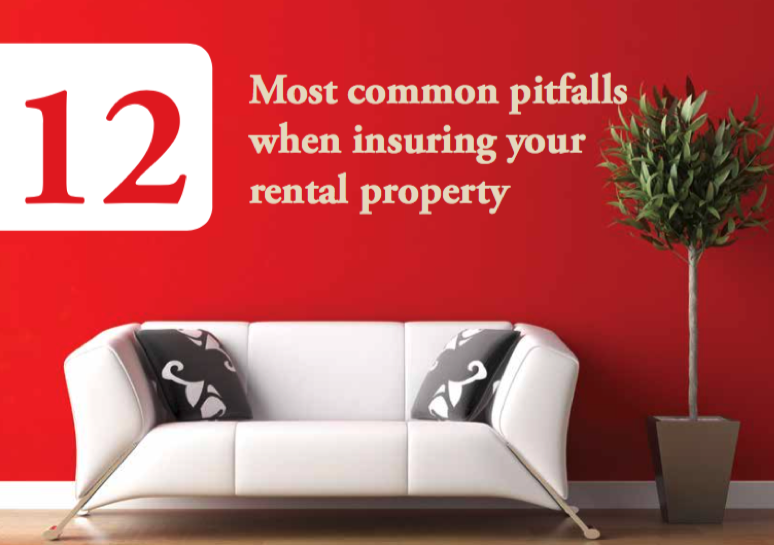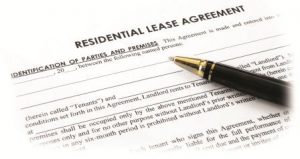The 12 Most Common Pitfalls When Insuring Your Rental Property

Buying a rental property can be a rewarding experience, but protecting your income and assets is paramount. After all, investing in property is a business and you need to safeguard against things that can go wrong beyond a fire or water damage. So choosing the right level of insurance cover is crucial.
The simple fact that not all insurance is the same makes it extremely difficult to weigh up the benefits of one policy versus another. Too often the glossiest brochure or the cheapest price wins out, and investors fail to put adequate thought into what is likely to occur should a claim be necessary.
When it comes to insuring a residential rental property, the differences between policies can be significant. Having been involved in landlord insurance since 1991, I will try to help identify some key mistakes that many investors tend to make.
1. Buying on price alone
 Like any business, Insurers are out to make a profit, effectively by paying out less in claims than they receive in premiums. Although price must always be considered as a factor in your buying decision the reality is that cheap cover is likely to represent poor value when it comes to making a claim.
Like any business, Insurers are out to make a profit, effectively by paying out less in claims than they receive in premiums. Although price must always be considered as a factor in your buying decision the reality is that cheap cover is likely to represent poor value when it comes to making a claim.
The adage “When you pay too much you may lose a little, but when you pay too little you may lose a lot” has never been so true as it is with landlord insurance. The number one priority must always be to ensure the right cover is being obtained. You should look to obtain “value” rather than “cheap”.
If there are risks that won’t be covered, make sure they’re risks you are willing to wear yourself should a loss occur.
In any policy, look for the specific types of damage that are covered. For example, some policies will cover malicious damage but not accidental (more on that later). So if you choose to have a policy that only covers malicious damage, you need to be willing to take the risk that if accidental damage occurs, you will not be covered and will need to wear the expense yourself. Choose wisely, or you will be self-insuring for some of the risks.
2. Deliberate fire by tenants
 Believe it or not, some Insurers will tell you they will not pay claims if a tenant has deliberately started a fire, on the basis that they exclude “malicious damage by the tenant”. This is often simply a case of companies not understanding their own policies well enough. For you as the investors, when it comes to the risk of a total loss – your property burnt to the ground – you simply cannot take any chances.
Believe it or not, some Insurers will tell you they will not pay claims if a tenant has deliberately started a fire, on the basis that they exclude “malicious damage by the tenant”. This is often simply a case of companies not understanding their own policies well enough. For you as the investors, when it comes to the risk of a total loss – your property burnt to the ground – you simply cannot take any chances.
One simple question to ask is, “Do you pay a claim where the tenant maliciously sets fire to my property?” This should give you some peace of mind, or tell you to look elsewhere.
Unfortunately, it can often be the case that even asking simple questions to phone staff can yield different answers. Insurance can be very technical, and the way a question is phrased can sometimes be interpreted in different ways. That said, this is an area you don’t want to leave to chance If you cannot be 100% confident that the answer you receive is what you want to hear, and is accurate, it’s worth checking further or find an Insurer you have confidence in.
3. Excesses
 When you make a claim, there will often be a portion that you must pay, known as the excess, before the claim is paid. Some Insurer’s charge ridiculous excesses which may almost render a claim worthless.
When you make a claim, there will often be a portion that you must pay, known as the excess, before the claim is paid. Some Insurer’s charge ridiculous excesses which may almost render a claim worthless.
Watch out in particular for those policies that charge an excess on Loss of Rent claims. You will benefit far more on policies that have a nil excess on loss of rent, and reasonable excesses on damage claims.
Ideally the policy should allow your bond to be used to pay the excess.
As a general rule all policies will have some form of excesses, but they can vary dramatically. Some of the major Insurer’s will not only apply an excess, sometimes equivalent to 4 weeks rent, but this may also be applied AFTER not paying the first 4 weeks. This is like a double whammy and could render your claim worthless. I assume they are working on the logic the there is a bond in place equivalent to 4 weeks rent, however that’s not taking into account all the other allowable deductions that are not covered by insurance, such as cleaning costs and minor damage.
4. Underinsurance
 Whether it be replacement of the whole building, your contents, or simply the risk of rent loss, your cash flow and assets are the lifeblood of a successful investment. Saving a few dollars by insuring for less than the true replacement value is simply ridiculous, and remember, insurance for your rental property is generally tax deductible.
Whether it be replacement of the whole building, your contents, or simply the risk of rent loss, your cash flow and assets are the lifeblood of a successful investment. Saving a few dollars by insuring for less than the true replacement value is simply ridiculous, and remember, insurance for your rental property is generally tax deductible.
Underinsurance is rampant in Australia. This is where you do not insure your property for its full value, the full replacement cost, and instead insure for a lesser amount. This practice, which is fraught with danger, is sometimes deliberate and intended to save a few dollars on the premium, although may also be inadvertent by not properly calculating the current replacement cost.
Statistics suggest that around 29% of homeowners in Australia don’t have home and contents insurance, and as many as 40% who do have insurance are underinsured.
5. Malicious Damage by the Tenant
 Ten years ago, very few policies covered Malicious Damage by the tenant. Today there are far more with it included, but it is something to check carefully as the limits and excesses can vary considerably. The consequences if not included can be quite horrific.
Ten years ago, very few policies covered Malicious Damage by the tenant. Today there are far more with it included, but it is something to check carefully as the limits and excesses can vary considerably. The consequences if not included can be quite horrific.
Bear in mind that “Malicious Damage” is a very specific term and when it comes to insurance, generally, you will need to prove that the damage was caused “maliciously”. This means that you need to prove that the tenant caused the damage with malicious intent, that their intention was “to damage your property”.
Example of what IS malicious damage:
A tenant has a dispute with a landlord and leaves the property, but before he does, he takes to the walls with a sledgehammer and indelibly leaves his mark. Presumably this would be reported to the police and would more than likely be classified by an Insurer as malicious damage.
Unfortunately, this need to prove malicious intent means that as much as 60-70% of damage claims will not be classified as malicious damage. So your policy needs to have more, which brings me to my next point.
6. Accidental Damage
 To prove Malicious Damage, you will generally require a police report, and technically you may need to prove that a tenant caused the damage with malicious intent, meaning that their sole aim was to cause damage to your property.
To prove Malicious Damage, you will generally require a police report, and technically you may need to prove that a tenant caused the damage with malicious intent, meaning that their sole aim was to cause damage to your property.
Look for a policy that has Accidental Damage, or at the very least includes “deliberate and intentional” which broadens it a little. Also ensure the Accidental Damage clause applies to both the building and contents. Some Insurers limit it to contents, which can leave you exposed in major situations.
Example of what IS NOT malicious damage:
A tenant has a particular attraction to the colour black, so she takes it upon herself to redecorate the entire inside of your property in this attractive colour. The tenant did not paint the walls with the intent of damaging your property. In her mind, she was enhancing it.
This situation is not likely to be classified by an Insurer as malicious damage. At the very best it would be classed as deliberate and intentional if your policy includes it. You would be even safer is to have accidental damage included.
There are many more examples of accidental damage such as:
- The tenant changes the engine oil of his prized Harley-Davidson on the living room carpet….and spills.
- A quiet celebration turns into an impromptu party and the result is red wine ruining your much-loved carpet.
- A tenant wants to hang pictures, so all over the house go picture hooks into your newly plastered walls. Under some policies, this may be payable as “deliberate & intentional” damage.
And then there’s the ones that simply aren’t the work of a “bad” tenant at all. Here’s an actual claim I came across:
- A tenant was teaching his wife to drive. She hit the mailbox, and then panicked, hitting the accelerator and causing more than $14,000 in damage and lost rent.
7. Check the Qualifying (or disqualifying) rules
 Some insurance companies will make putting a policy in place very technical, although you may not find this out until you go to make a claim, unless you’re an expert on fine print. Some policies require the tenant to not have been in arrears at any stage during the preceding two months where a breach notice could have been issued, or else some cover may be restricted.
Some insurance companies will make putting a policy in place very technical, although you may not find this out until you go to make a claim, unless you’re an expert on fine print. Some policies require the tenant to not have been in arrears at any stage during the preceding two months where a breach notice could have been issued, or else some cover may be restricted.
Look for a policy that keeps it simple, unless you are 100% sure of your tenant’s history, in strict accordance with both the legislation and the policy conditions.
Ideally the policy you arrange should keep it logical, in fact pretty much common sense. I expect all policies will require you to have a bond equivalent to at least four weeks rent, so that’s a given. It is also logical that the tenant should be up to date with their rent at the time of taking out the policy.
But where it becomes more difficult is if the policy has conditions that refer to the tenant’s history, such as if the tenant has been in arrears in recent times. From a landlord point of view, if your property is managed, you may not even necessarily know for certain whether this is the case.
By agreeing to conditions like this, you could find yourself with a denied claim months or even years down the track, all because when you arranged the policy the tenant had a not so perfect history.
Keep it simple. Make sure you abide by the rules of arranging the policy, but make sure they’re fair.
8. Check for complete cover
 Policies vary in the way they cover your property. If you have a house you may need two policies: a building defined events policy as well as a landlord policy. Some of the combined policies that have hit the markets in recent years may fall well short of the mark when it comes time to make a claim, so don’t be fooled by the lure of the “big name” Insurer and the promise of a low price. There’s generally a reason the premium is so attractive.
Policies vary in the way they cover your property. If you have a house you may need two policies: a building defined events policy as well as a landlord policy. Some of the combined policies that have hit the markets in recent years may fall well short of the mark when it comes time to make a claim, so don’t be fooled by the lure of the “big name” Insurer and the promise of a low price. There’s generally a reason the premium is so attractive.
That’s not to say combined policies are no good, just be sure it is a “genuine” landlord policy and not simply a pumped-up household policy.
There was a time when landlord insurance was a bit of a novelty. Only a handful, in fact less than a handful, of providers offered the cover. That was the early 90s. Jump forward 25 years and there are any number of policies available from all sorts of companies. The problem is determining the quality products from the pretenders.
Many policies on the market today are likely to be household policies that have had a few features tacked on and renamed as a landlord insurance policy. It’s in the detail that you will find the difference. Look for features such as “tenant hardship”, “death of a tenant” and “denial of access”, along with the accidental damage already mentioned. These should be a few indicators of a policy that has been designed with some property management industry knowledge.
9. Court Orders
 Some policies talk about long periods of rent loss being covered simply for “default.” On closer inspection, you are likely to find that court orders are required for anything other than the most basic periods.
Some policies talk about long periods of rent loss being covered simply for “default.” On closer inspection, you are likely to find that court orders are required for anything other than the most basic periods.
That’s okay, but be sure you know what it is you’re getting so that you can make sure you get the most out of the policy conditions.
Policies these days don’t have “fine print” and are written in “Plain English”. That’s not to say they are simple to understand for the average person. You are entering into a contract with an Insurer, so there is a lot that needs to be spelt out and itemised down to the finest detail, in an attempt to cover such a wide variety of potential risks. The issue of how much rent is payable under what circumstances is certainly one that needs close attention. You are likely to find specific conditions that need to be met before you are entitled to the full extent of rent loss. In other cases, lesser amounts will be payable.
10. The Body Corporate already insures my property.
 Wrong.
Wrong.
The Body Corporate (or Owners Corporation) may be required to insure the building and common grounds in a strata-titled property, but the moment someone steps inside your unit or townhouse, the problem is yours.
This is a common misconception where many landlords believe if they own a strata-titled property they do not need their own insurance, as the Body Corporate will cover it. In most circumstances this is certainly not the case. The Body Corporate will generally cover the building structure and common areas such as the grounds, driveways, pools etc., but they do not cover the interior of your unit or townhouse.
Your “contents” such as your carpets, curtains, blinds and light fittings, plus often the interior paintwork and various other fixtures and fittings, need to be insured by you, the property owner. This includes insurance against defined risks such as fire, storm and water damage, as well as tenant-related risks such as malicious and accidental damage.
The most significant risk to an investor is liability should someone injure themselves inside your premises and place you at fault. The legal bills alone can be catastrophic. These days your policy should include at least $20,000,000 liability cover. In all honesty, you can’t have too much.
11. Periodic Tenancies or Lease Continuation
 Most landlord insurance policies require the tenant to at least have initially been on a written lease and most likely for a fixed term. The length of the required fixed term of the agreement may vary between policies but the simple logic is that there needs to be some sort of written agreement in place for the tenant to be deemed as having done something wrong.
Most landlord insurance policies require the tenant to at least have initially been on a written lease and most likely for a fixed term. The length of the required fixed term of the agreement may vary between policies but the simple logic is that there needs to be some sort of written agreement in place for the tenant to be deemed as having done something wrong.
What has come to light in more recent years however is that some policies will not pay claims if the written lease has expired, and the tenants have simply rolled on to a “periodic lease” or “lease continuation”. This could be a major problem. Check your policy immediately. You can’t afford to find out that you are no longer insured at the time when you try to make a claim.
A check of the definition of a lease is the most important thing to do in this case. This may be a reference to a “written agreement” or similar. Ideally you are looking for terms that refer specifically to including a “periodic tenancy”, a “tenancy at will”, or some reference to the cover continuing for the period immediately following the end of a fixed term lease or rental agreement.
If your policy references simply that there is a requirement of a “written agreement” in place, you need to be careful. There are plenty of landlords who have been caught out, expecting that the policy continued once the fixed term ceased but the tenant stayed on, only to find out otherwise when they went to make a claim.
12. When you figure out “you don’t need insurance”
 To say I’ve heard them all would be an understatement. “My tenant has been there for 6 years and I’ve never had a problem” – that’s until the job loss, or the illness, or the marital dispute. “That’s what I pay my property manager for, to make sure I don’t have problems” – and property managers are generally clairvoyants that can foresee all the problems that happen in people’s lives.
To say I’ve heard them all would be an understatement. “My tenant has been there for 6 years and I’ve never had a problem” – that’s until the job loss, or the illness, or the marital dispute. “That’s what I pay my property manager for, to make sure I don’t have problems” – and property managers are generally clairvoyants that can foresee all the problems that happen in people’s lives.
Insurance is what we call a “grudge buy.” Nobody wants it, but you’re running a business, and to not protect yourself is just plain dumb.
Television and newspapers often relate the stories of people who have suffered losses and were uninsured. No-one is immune from the risks that insurance is designed to cover: natural events such as a storm, a bushfire or a fire that starts through an electrical fault, and the multitude of other things that can go wrong including tenant-related losses. Let’s not forget the very real risk of liability claims which can amount to millions of dollars.
No amount of care can ensure you do not suffer a loss. The bottom line is, if you choose not to insure, you’d better be prepared to wear the losses should the unthinkable occur.
My advice about insurance is provided for your general information and does not take into account your individual needs. You should read the Product Disclosure Statement and Policy Wording prior to making a decision. These can be obtained directly from EBM.
Comments
Got something to say? Post a comment...
You must be logged in to post a comment.





Hi Brett,
Thank you SO MUCH for putting this together. This should be “required reading” for all – right away, as a 12 month refresher, or whenever one is reviewing their Landlord Insurance. Some of the traps hidden in here are almost unbelievable. They are the ones that need the most consideration.
For mine, #11 (where a tenant exits a lease and goes to “month to month”) is one such danger. Who would have thought that this innocuous event could upset a landlord’s insurance applecart? And your warnings re “intentional vs unintentional damage by a tenant” are well received too. Who knew?
You did ! And thanks for sharing so completely right here.
Benny
Good advice and should be mandatory minimum reading by any rental property owner. Having just come through an insurance claim I can add that the hassle of dealing with the insurer and arranging tradesmen is far more traumatic than the damage caused by the tenant though obviously they are the root cause. Damage got classified as Accidental, malicious and Intentional damage all got their own excesses, with additional $400 excess (see the small print) for M and I. Other damage classed as fair wear and tear which can include holes in the wall and broken wardrobe doors. Strangely, and worth noting, where the tenant had made a hole in a wall was fair wear, but where he had tried to repair was intentional damage and claimable. Despite $20K of damage the insurer declared it ‘habitable’ and thus not eligible for loss of rent, despite it being unfit to rent. Insurers will also offer to fix damage or make a payment. In the former case this will mean repainting a wall but not the one next to it with FW&T damage, or replacing one blind in a room with different fabric from the other blind as a match no longer exists. We took the money $16K and were able to repair whole house but only because original builder (house only just over 1 year old) assisted, bless them. Overall loss was around $5K which would have been covered by loss of rent if covered. Nor are we covered for time to resolve- ie insurer assessor missed items and we took weeks to resolve claim, as well as lack of tradies over Christmas. Again, only resolved due to original builder stepping in to help a repeat client. In summary, really read the p.d.s and ask the questions posed in the article. Thanks for reading
Richard…..who was your insurer?
We recently heard of an ice lab setting up next door to a friend’s unit. Our friend moved out immediately, fearing the potential effects on his pregnant wife and small child. The owner of the affected neighbouring unit will have to strip the unit back to its structure, including removing all the plasterboard, floor coverings, lights, curtains, cupboards, wardrobes, etc, etc. The chemicals used in making drugs seep into any porous materials. Even plasterboard. The rectification cost to the owner will be huge.
Investors – check your insurance policy to see if it covers you for this kind of risk. And make sure you have the best property manager money can buy. If you had one and they rented your unit to ‘druggies’, you may be able to make a claim on their PI insurance…maybe. Of course, some undesirable tenants are clever at getting past property manager’s checks.
It’s a growing problem that needs to be taken very seriously. As you’ve said, the cost of rectification can be very high and is the reason why with RentCover we have increased the limit for this type of claim to $65,000.